Fast food: Difference between revisions
No edit summary |
Darth Panda (talk | contribs) m Reverted edits by 66.102.16.10 to last revision by ClueBot (HG) |
||
| Line 1: | Line 1: | ||
{{for|the Atari 2600 game|Fast Food (video game)}} |
{{for|the Atari 2600 game|Fast Food (video game)}} |
||
[[ |
[[File:2008-0614-In-N-Out-burgsfries.jpg|thumb|A typical fast food meal in the [[United States]] consists of fries and a burger (or other main item).]] |
||
'''Fast food ''' is the term given to food that can be prepared and served very quickly. While any meal with low preparation time can be considered to be fast food, typically the term refers to food sold in a [[restaurant]] or store with low quality preparation and served to the customer in a packaged form for [[Take-out|take-out/take-away]]. The term "fast food" was recognized in a dictionary by [[Merriam–Webster]] in 1951.<ref>[http://www.jackinthebox.com/pressroom/factssheet_co.php Jack In The-Box Inc. Fact Sheet]</ref> |
|||
Outlets may be stands or [[kiosk]]s, which may provide no shelter or seating,<ref>{{cite book | title = Fast Food: Roadside Restaurants in the Automobile Age | first = John | last = Jakle | publisher = Johns Hopkins University Press | year = 1999 | id = ISBN 080186920X }}; {{cite book | title = Texts Under Negotiation: The Bible and Postmodern Imagination | first = Walter | last = Brueggemann | publisher = Fortress Press | year = 1993 | isbn = 0800627369 }}</ref> or [[fast food restaurant]]s (also known as ''quick service restaurants''). [[Franchising|Franchise]] operations which are part of [[Chain store|restaurant chains]] have standardized foodstuffs shipped to each restaurant from central locations.<ref>{{cite book | title = Fast Food, Fast Track: Immigrants, Big Business, and the American Dream | first = Jennifer | last = Talwar | publisher = Westview Press | year = 2003 | isbn = 0813341558 }}</ref> |
Outlets may be stands or [[kiosk]]s, which may provide no shelter or seating,<ref>{{cite book | title = Fast Food: Roadside Restaurants in the Automobile Age | first = John | last = Jakle | publisher = Johns Hopkins University Press | year = 1999 | id = ISBN 080186920X }}; {{cite book | title = Texts Under Negotiation: The Bible and Postmodern Imagination | first = Walter | last = Brueggemann | publisher = Fortress Press | year = 1993 | isbn = 0800627369 }}</ref> or [[fast food restaurant]]s (also known as ''quick service restaurants''). [[Franchising|Franchise]] operations which are part of [[Chain store|restaurant chains]] have standardized foodstuffs shipped to each restaurant from central locations.<ref>{{cite book | title = Fast Food, Fast Track: Immigrants, Big Business, and the American Dream | first = Jennifer | last = Talwar | publisher = Westview Press | year = 2003 | isbn = 0813341558 }}</ref> |
||
Revision as of 16:34, 10 February 2009

Fast food is the term given to food that can be prepared and served very quickly. While any meal with low preparation time can be considered to be fast food, typically the term refers to food sold in a restaurant or store with low quality preparation and served to the customer in a packaged form for take-out/take-away. The term "fast food" was recognized in a dictionary by Merriam–Webster in 1951.[1]
Outlets may be stands or kiosks, which may provide no shelter or seating,[2] or fast food restaurants (also known as quick service restaurants). Franchise operations which are part of restaurant chains have standardized foodstuffs shipped to each restaurant from central locations.[3]
The capital requirements involved in opening up a fast food restaurant are relatively low. Smaller, individually-owned fast food restaurants are becoming much more common throughout the world.[citation needed] Restaurants with much higher sit-in ratios, where customers tend to sit and have their orders brought to them in a seemingly more upscale atmosphere, may be known in some areas as fast casual restaurants.
History
The concept of ready-cooked food for sale is closely connected with urban development. In Ancient Rome cities had street stands that sold bread and wine, East Asian featured noodle shops. Flatbread and falafel are today ubiquitous in the Middle East. Popular Indian fast food dishes include vada pav, panipuri and dahi vada. In the French-speaking nations of West Africa, roadside stands in and around the larger cities continue to sell—as they have done for generations—a range of ready-to-eat, char-grilled meat sticks known locally as brochettes (not to be confused with the bread snack of the same name found in Europe).
Pre-modern Europe
In the cities of Roman antiquity, much of the urban population living in insulae, multi-story apartment blocks, depended on food vendors for much of their meals. In the mornings, bread soaked in wine was eaten as a quick snack and cooked vegetables and stews later in the day at a popina, a simple type of eating establishment.[4] In the Middle Ages, large towns and major urban areas such as London and Paris supported numerous vendors that sold dishes such as pies, pasties, flans, waffles, wafers, pancakes and cooked meats. As in Roman cities during antiquity, many of these establishments catered to those who did not have means to cook their own food, particularly single households. Unlike richer town dweller, they could often not afford to rent housing with kitchen facilities or even to buy cooking equipment. This was recognized by authorities, and in English cities like Coventry and London, price controls on meat pies were enforced. Travellers, such as pilgrims en route to a holy site, whether rich or poor, were also among the customers.[5]
Modern era
United Kingdom

In areas which had access to coastal or tidal waters, 'fast food' would frequently include local shellfish or seafood, such as oysters or, as in London, eels. Often this seafood would be cooked directly on the quay or close by.[6] The development of trawler fishing in the mid 19th century[citation needed] would lead to the development of a British favorite fish and chips partly due to such activities.[citation needed]
Owing to differing availability of ingredients and tastes, until the Great War, British fast food had considerable regional variation. Sometimes the regionality of dish became part of the culture of its respective area.
The content of fast food pies has varied, with poultry (such as chickens) or wildfowl commonly being used. After World War II, turkey has been used more frequently in fast food.[7]
A particularly British form of fast food is the sandwich, popularised by John Montagu, the 4th Earl of Sandwich in 1762 when he wrapped dried meat in bread so as not to interrupt his work or his gambling (accounts vary).[8][9] The sandwich has similarities in other cuisines and cultures such as the filled baguettes popular in France. Despite its wide appeal and consumption in the UK, it is only in recent years that the sandwich in its various forms has been considered to be fast food,[citation needed] initially being promoted as such by niche chains such as Subway and Pret a Manger.[citation needed]
As well as its native forms, the UK has adopted fast food from other cultures, such as pizza (Italian), Chinese noodless, kebab and various other forms of fast foods come from other parts of the Commonwealth of Nations. and further afield.[10] In some areas imported fast food has become part of both the local, and British culture in general.[citation needed] More recently healthier alternatives to conventional fast food have also emerged.
Recently on New Year's Day 2008 a study was conducted worldwide counting the number of fast food restaurants per person. The UK has claimed this title with Australia second and the United States third. England alone accounted for 25% of all fast food.[citation needed]
United States
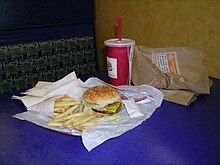
In 1867, Charles Feltman, a German butcher, opened up the first Coney Island hot dog stand in Brooklyn, New York City, though the origin of the term is in dispute. The World's Columbian Exposition (Chicago 1893) and the St. Louis World's Fair of 1904 are credited with mass promotion of a number of portable foods, including the hot dog, the ice cream cone and iced tea.
The "diner" concept dates back to 1872, when Walter Scott of Providence, Rhode Island outfitted a horse-drawn lunch wagon with a simple kitchen so that he could bring hot dinners to workers.[9]
The modern history of fast food restaurants in the United States is often traced to July 7, 1912 with the opening of a fast food restaurant in New York City by Horn & Hardart. Their Automat was a cafeteria featuring prepared foods behind small glass windows and coin-operated slots. This was patterned after a Horn & Hardart Automat that had opened in Philadelphia in 1902. Numerous Automat restaurants were quickly built around the country to deal with the demand. Automats remained extremely popular throughout the 1920s and 1930s. The company also popularized the notion of "take-out" food, with their slogan "Less work for Mother".
As automobiles became popular and affordable following the First World War, drive-in restaurants were introduced. The American company White Castle, founded in 1921 by Billy Ingram and Walter Anderson in Wichita, Kansas in 1921, is generally credited with opening the second fast food outlet and first hamburger chain, selling hamburgers for five cents apiece.[11] Walter Anderson had built the first White Castle restaurant in Wichita in 1916, introducing the limited menu, high volume, low cost, high speed hamburger restaurant.[9] Among its innovations, the company allowed customers to see the food being prepared. White Castle later added five holes to each beef patty to increase its surface area and speed cooking times. White Castle was successful from its inception and spawned numerous competitors.
Franchising was introduced in 1921 by A&W Root Beer, which franchised its distinctive syrup. Howard Johnson's first franchised the restaurant concept in the mid-1930s, formally standardizing menus, signage and advertising.[9]
Curb service was introduced in the late 1920s and was mobilized in the 1940s when carhops strapped on roller skates.[12]
McDonald's
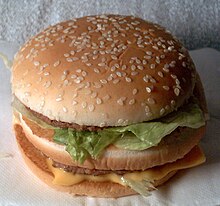
McDonald's, the largest fast food chain in the world and the brand most associated with the term "fast food," was founded as a barbecue drive-in in 1940 by Dick and Mac McDonald. After discovering that most of their profits came from hamburgers, the brothers closed their restaurant for three months and reopened it in 1948 as a walk-up stand offering a simple menu of hamburgers, French fries, milkshakes, coffee, and Coca-Cola, served in disposable paper wrapping. As a result, they were able to produce hamburgers and fries constantly, without waiting for customer orders, and could serve them immediately; hamburgers cost 15 cents, about half the price at a typical diner. Their streamlined production method, which they named the "Speedee Service System" was influenced by the production line innovations of Henry Ford. The McDonalds' stand was the milkshake machine company's biggest customer and a milkshake-machine salesman named Ray Kroc traveled to California to discover the secret to their high-volume burger-and-shake operation. Kroc thought he could expand their concept, eventually buying the McDonalds' operation outright in 1961 with the goal of making cheap, ready-to-go hamburgers, french fries and milkshakes a nationwide business.[13]
Kroc was the mastermind behind the rise of McDonald's as a national chain. The first part of his plan was to promote cleanliness in his restaurants. Kroc often took part at his own Des Plaines, Illinois, outlet by hosing down the garbage cans and scraping gum off the cement. Kroc also added great swaths of glass which enabled the customer to view the food preparation. This was very important to the American public which became quite germ conscious. His motto "If you have time to lean you have time to clean" can still be heard in the ears of crew workers today. A clean atmosphere was only part of Kroc's grander plan which separated McDonald's from the rest of the competition and attributed to their great success. Kroc envisioned making his restaurants appeal to suburban families.[14]
On the go
Fast food outlets are take-away or take-out providers, often with a "drive-through" service which allows customers to order and pick up food from their cars; but most also have a seating area in which customers can eat the food on the premises. People eat there more than five times a week[15] and often, one or more of those five times is at a fast food restaurant.
Nearly from its inception, fast food has been designed to be eaten "on the go", often does not require traditional cutlery, and is eaten as a finger food. Common menu items at fast food outlets include fish and chips, sandwiches, pitas, hamburgers, fried chicken, French fries, chicken nuggets, tacos, pizza, hot dogs, and ice cream, although many fast food restaurants offer "slower" foods like chili, mashed potatoes, and salads.
Filling stations
Many petrol/gas stations have convenience stores which sell pre-packaged sandwiches, doughnuts, and hot food. Many gas stations in the United States also sell frozen foods and have microwaves on the premises in which to prepare them.
Street vendors and concessions
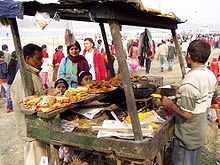
Traditional street food is available around the world, usually from small operators and independent vendors operating from a cart, table, or portable grill. Common examples include Vietnamese noodle vendors, Middle Eastern falafel stands and New York City hot dog carts. Turo-Turo vendors (Tagalog for point point) are a feature of Philippine life. Commonly, street vendors provide a colorful and varying range of options designed to quickly captivate passers-by and attract as much attention as possible.
Depending on the locale, multiple street vendors may specialize in specific types of food characteristic of a given cultural or ethnic tradition. In some cultures, it is typical for street vendors to call out prices, sing or chant sales-pitches, play music, or engage in other forms of "street theatrics" in order to engage prospective customers. In some cases, this can garner more attention than the food itself; some vendors represent another form of tourist attraction.
Cuisine

Modern commercial fast food is often highly processed and prepared in an industrial fashion, i.e., on a large scale with standard ingredients and standardized cooking and production methods. It is usually rapidly served in cartons or bags or in a plastic wrapping, in a fashion which minimizes cost. In most fast food operations, menu items are generally made from processed ingredients prepared at a central supply facility and then shipped to individual outlets where they are reheated, cooked (usually by microwave or deep frying) or assembled in a short amount of time. This process ensures a consistent level of product quality, and is key to being able to deliver the order quickly to the customer and eliminate labor and equipment costs in the individual stores.
Because of commercial emphasis on speed, uniformity and low cost, fast food products are often made with ingredients formulated to achieve a certain flavor or consistency and to preserve freshness.
Variants
Although fast food often brings to mind traditional American fast food such as hamburgers and fries, there are many other forms of fast food that enjoy widespread popularity in the West.
Chinese takeaways/takeout restaurants are particularly popular. They normally offer a wide variety of Asian food (not always Chinese), which has normally been fried. Most options are some form of noodles, rice, or meat. In some cases, the food is presented as a smörgåsbord, sometimes self service. The customer chooses the size of the container they wish to buy, and then is free to fill it with their choice of food. It is common to combine several options in one container, and some outlets charge by weight rather than by item. Many of these restaurants offer free delivery for purchases over a minimum amount.

Sushi has seen rapidly rising popularity in recent times. A form of fast food created in Japan (where bentō is the Japanese equivalent of fast food), sushi is normally cold sticky rice served with raw fish. The most popular kind in the West is rolls of rice in nori (dried laver), with filling. The filling often includes fish, chicken or cucumber.
Pizza is a common fast food category in the United States, with chains such as Domino's Pizza, Sbarro and Pizza Hut. Menus are more limited and standardized than in traditional pizzerias, and pizza delivery, often with a time commitment, is offered.
Kebab houses are a form of fast food restaurant from the Middle East , especially Turkey and Lebanon. Meat is shaven from a rotisserie, and is served on a warmed flatbread with salad and a choice of sauce and dressing. These doner kebabs are distinct from shish kebabs served on sticks. Kebab shops are also found throughout the world, especially Europe, but they generally are less common in the US.
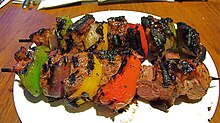
Fish and chip shops are a form of fast food popular in the United Kingdom, Australia and New Zealand. Fish is battered and then deep fried.
The Dutch have their own types of fast food. A Dutch fast food meal often consists of a portion of French fries (called friet or patat) with a sauce and a meat product. The most common sauce to accompany French fries is mayonnaise, while others can be ketchup or spiced ketchup, peanut sauce or piccalilli. Sometimes the fries are served with combinations of sauces, most famously speciaal (special): mayonnaise, with (spiced) ketchup and chopped onions; and oorlog (literally "war"): mayonnaise and peanut sauce (sometimes also with ketchup and chopped onions).
The meat product is usually a deep fried snack; this includes the frikandel (a deep fried skinless minced meat sausage), and the kroket (deep fried meat ragout covered in breadcrumbs).
Business
In the United States alone, consumers spent about US$110 billion on fast food in 2000 (which increased from US$6 billion in 1970).[16] The National Restaurant Association forecasts that fast food restaurants in the U.S. will reach US$142 billion in sales in 2006, a 5% increase over 2005. In comparison, the full-service restaurant segment of the food industry is expected to generate $173 billion in sales. Fast food has been losing market share to fast casual dining restaurants, which offer more robust and expensive cuisines.[17]
Jobs and labor issues
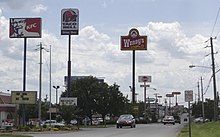
Ray Kroc may very well be considered the father of fast food franchising. As he recounts[18] his agreement with the McDonalds Brother's gave Kroc 1.9% of gross sales of franchisees. The age of the fast food restaurant franchise had arrived in the United States.
As the number of fast food restaurants proliferated, so did job opportunities. Today, approximately 2 million workers are employed in the areas of food preparation and food servicing including fast food in the USA.[19] With the advent of such a large workforce, the franchisee now faced two issues that could sap profit from the fast food restaurant franchise and expose the owner-operator to significant liability and financial loss. The first is controlling labor costs as these costs are crucial to a fast food restaurant franchisee's profits. The second, employee lawsuits; an ever-growing phenomenon. Fortunately, the fast food operator is able to control costs and guard against employee lawsuits with the same tool.
First the issue of labor costs. Employees are the backbone of the fast food industry. Proper training is crucial to the orderly and quick service customers expect. Yet, employee turnover can be as high as 200% per year.[20] With such a turnover, owner-operators of franchise and non-fanchise restaurants have the daunting task of constantly training an entirely new workforce. Policies and procedues need to be explained to each new employee. For example, sanitation is crucial as is knowing how to act in a robbery situation. Break and clocking-in policies must be observed. With the constantly changing workforce, an owner operator using an effective employee manual can quickly train new employees on what is expected of the employee and what the general practices and procedures are of proper employee conduct.
The second issue facing all employers and especially fast food restaurant owner-operators is the steady increase in employment practices lawsuits. The restaurant industry with its high emotional content is a frequent target of discrimination claims.[21] About 500 employment practices lawsuits ae filed in the United State everyday. Many employers believe that the greatest legal threat that companies face are employee lawsuits.[22]
Globalization

In 2006, the global fast food market grew by 4.8% and reached a value of 102.4 billion and a volume of 80.3 billion transactions.[23] In India alone the fast food industry is growing by 40% a year.[24]
McDonald's is located in 120 countries and operates 30,000 restaurants around the world.[25] On January 31, 1990 McDonald’s opened a restaurant in Moscow, and broke opening day records for customers served. The Moscow restaurant is the busiest in the world. The largest McDonald’s in the world is located in Beijing, People's Republic of China.
There are numerous other fast food restaurants located all over the world. Burger King has more than 11,100 restaurants in more than 65 countries.[26] KFC is located in 25 countries.[27] Subway has 29,186 restaurants located in 86 countries, the first non-US location opening in December 1984 in Bahrain.[28] Pizza Hut is located in 26 countries, with 100 locations in China.[29] Taco Bell has 278 restaurants located in 12 countries besides the United States.[30]
Criticism
Fast food chains have come under fire from consumer groups, such as the Center for Science in the Public Interest, a longtime fast food critic over issues such as caloric content, trans fats and portion sizes.
Some of the concerns have led to the rise of the Slow Food, or local food movements. These movements seek to preserve local cuisines and ingredients, and directly oppose laws and habits that favor fast food choices. Proponents of the slow food movement try to educate consumers about what its members considers the richer, more varied and more nourishing tastes of fresh, local ingredients that have been recently harvested.
Health issue
Trans fats which are commonly found in fast food have been shown in many tests to have a negative health effect on the body. A 2006 study[31] fed monkeys a diet consisting of a similar level of trans fats as what a person who ate fast food regularly would consume. Both diets contained the same overall number of calories. It was found that the monkeys who consumed higher level of trans fat developed more abdominal fat than those fed a diet rich in unsaturated fats. They also developed signs of insulin resistance, which is an early indicator of diabetes. After six years on the diet, the trans fat fed monkeys had gained 7.2% of their body weight, compared to just 1.8% in the unsaturated fat group.
The director of the obesity program for the Children's Hospital Boston, David Ludwig, claims that "fast food consumption has been shown to increase calorie intake, promote weight gain, and elevate risk for diabetes".[32] The Centers for Disease Control and Prevention ranked obesity as the number one health threat for Americans in 2004.[33] It is the second leading cause of preventable death in the United Sates and results in 400,000 deaths each year.[33] About 60 million American adults are classified as being obese with another 127 million being overweight.[33] Health issues associated with obesity causes economic despair regarding health care. According to a 2003 study conducted by RTI International in North Carolina, the cost of health care in America is said to increase by $93 billion a year, mainly from Type 2 diabetes and heart disease, both associated with obesity.[32]
Excessive calories are another issue with fast food. A regular but not overly filling meal at McDonald's of a Big Mac, large fries, and a large Coca-Cola drink amounts to 1430 calories. A diet of approximately 2000 calories is considered a healthy amount of calories for an entire day (which is different depending on several factors such as weight, height, physical activity and gender).
See also
- Dieting
- Food groups
- Fast Food Nation
- Junk food
- Super Size Me
- Western pattern diet
- Chew on This
- List of fast food restaurants
Notes
- ^ Jack In The-Box Inc. Fact Sheet
- ^ Jakle, John (1999). Fast Food: Roadside Restaurants in the Automobile Age. Johns Hopkins University Press. ISBN 080186920X.; Brueggemann, Walter (1993). Texts Under Negotiation: The Bible and Postmodern Imagination. Fortress Press. ISBN 0800627369.
- ^ Talwar, Jennifer (2003). Fast Food, Fast Track: Immigrants, Big Business, and the American Dream. Westview Press. ISBN 0813341558.
- ^ Stambaugh (1988), pp. 200, 209.
- ^ Martha Carling, "Fast Food and Urban Living Standards in Medieval England" in Food and Eating in Medieval Europe, pp. 27–51.
- ^ BBC (2006). "Eel and pie shop". BBC. Retrieved November 23 2007.
{{cite web}}: Check date values in:|accessdate=(help); Unknown parameter|dateformat=ignored (help) - ^ BBC News (2007). "How turkey became a fast food". BBC. Retrieved November 23 2007.
{{cite web}}: Check date values in:|accessdate=(help); Unknown parameter|dateformat=ignored (help) - ^ Linda Stradley. "History of Sandwiches". What's Cooking America. Retrieved June 26 2008.
{{cite web}}: Check date values in:|accessdate=(help); Unknown parameter|dateformat=ignored (help) - ^ a b c d James P Farrell. "The Evolution of the Quick Service Restaurant". A Management Consultant @ Large. Retrieved February 14 2008.
{{cite web}}: Check date values in:|accessdate=(help); Unknown parameter|dateformat=ignored (help) - ^ World InfoZone Ltd. "United Kingdom Information". World InfoZone Ltd. Retrieved November 23 2007.
{{cite web}}: Check date values in:|accessdate=(help); Unknown parameter|dateformat=ignored (help) - ^ National Public Radio (2002). "The Hamburger". NPR. Retrieved November 23 2007.
{{cite web}}: Check date values in:|accessdate=(help); Unknown parameter|dateformat=ignored (help) - ^ See Honk for Service by Lou Ellen Mcginley with Stephanie Spurr (Tray Days Publishing, 2004)
- ^ See Grinding It Out: The Making of McDonald's by Ray Kroc with Robert Anderson (St. Martin's Press, 1992)
- ^ "Where White Tower (one of the original fast food restaurants) had tied hamburgers to public transportation and the workingman…McDonald's tied hamburgers to the car, children, and the family.DuDe" (Levinstein, p.228-229)
- ^ Arndt
- ^ Schlosser, Eric (2001). Fast Food Nation: The Dark Side of the All-American Meal. Houghton Mifflin Books. ISBN 0395977894.
- ^ John Eligon (2008-01-13). "Where to Eat? A New Restaurant Genre Offers Manhattan More Choices". The New York Times. Retrieved 2008-12-30.
Though still a relatively small sector within the nation's $350 billion restaurant industry, several fast-casual chains are showing success and growth in Manhattan, and industry experts say it could be a sign of the sector's maturity and sustainability nationwide.
{{cite web}}: Check date values in:|date=(help) - ^ R. Kroc, Grinding It Out. The Making of McDonald's, Berkley Medallion Books, 1977, p. 72
- ^ U.S. Bureau of Labor Statistics, Occupational Employment Statistics
- ^ White, E. Wall Street Journal 2/17/2005 p.A1
- ^ Cornell Hotel & Restaurant Administration Quarterly, February, 2007.
- ^ CFO.com The Enemy Within.
- ^ Research and Markets
- ^ Worldwatch Institute
- ^ The Fast Food Factory
- ^ Burger King
- ^ KFC
- ^ Subway
- ^ Pizza Hut
- ^ Taco Bell
- ^ Why fast foods are bad, even in moderation
- ^ a b Warner
- ^ a b c Obesity
References
- Adams, Catherine. "Reframing the Obesity Debate: McDonald’s Role May Surprise You." Journal of Law, Medicine, and Ethics 35 (2007): 154-157. Academic Search Premier. EBSCOhost. University of Nevada, Reno Libraries. 5 February 2008.
- Arndt, Michael. "McDonald’s 24/7." Business Week 4020 (2007): 64-72. Academic Search Premier. EBSCOhost. University of Nevada, Reno Libraries. 22 February 2008.
- Food and Eating in Medieval Europe. Martha Carlin and Joel T. Rosenthal (editors). The Hambledon Press, London. 1998. ISBN 1-85285-148-1
- Hogan, David. Selling 'em by the Sack: White Castle and the Creation of American Food. New York: New York University Press, 1997.
- Kroc, Ray with Robert Anderson. Grinding It Out: The Making of McDonald's. St. Martin's Press, 1992.
- Levinstein, Harvey. Paradox of Plenty: a Social History of Eating in Modern America. Berkeley: University of California P, 2003. 228-229.
- Luxenberg, Stan. Roadside Empires: How the Chains Franchised America. New York: Viking, 1985.
- McGinley, Lou Ellen with Stephanie Spurr, Honk for Service: A Man, A Tray and the Glory Days of the Drive-In. St. Louis: Tray Days Publishing, 2004. For photos of the Parkmoor Restaurants see Drive-In Restaurant Photos
- Obesity In America. The Endocrine Society; The Hormone Foundation. 27 April 2008 The Obesity Crisis: What's it all about?
- Schlosser, Eric, Fast Food Nation: The Dark Side of the All-American Meal, Houghton Mifflin Company, 2001
- Schultz, Howard with Dori Jones Yang, Pour Your Heart Into It: How Starbucks Built a Company One Cup at a Time, Hyperion, 1999
- Stambaugh, John E., The Ancient Roman City JHU Press, 1988. ISBN 9780801836923.
- Warner, Melanie "Salads or No, Cheap Burgers Revive McDonald’s." The New York Times 19 April, 2006. Academic Search Premier. EBSCOhost. University of Nevada, Reno Libraries. 5 February 2008.
External links
- QSR magazine - publication that covers the fast food industry
- The British Library - Fast Food and Snacks Industry Guide (sources of information)
- Vegan Eating Out - Vegan fast food menu options.
